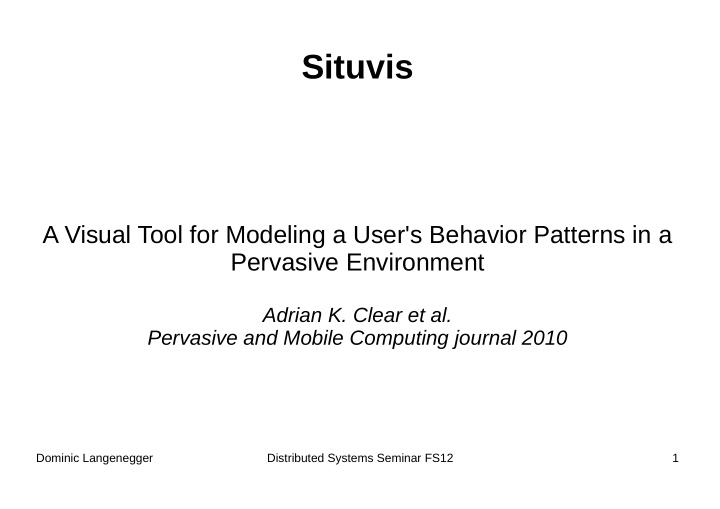



Situvis A Visual Tool for Modeling a User's Behavior Patterns in a Pervasive Environment Adrian K. Clear et al. Pervasive and Mobile Computing journal 2010 Dominic Langenegger Distributed Systems Seminar FS12 1
Overview ● Situation, Goal & Approaches ● Situvis – Sample Data collection – Visualization of Context Data – Evaluating Situations – User Study ● Future Work ● Feedback and Reviews ● Discussion 2
Situation & Goal ● Support user's goal by making adaptions to their behaviors ● Accuracy and utility of adaptions are predicated on system's ability to capture and recognize the circumstances ● System designer has to characterize adaption opportunities – Voluminous, highly multivariate, constantly updated context data – Multiple heterogeneous sensors ➔ Want to recognize high-level “Situations” out of low-level data 3
Usual Approaches ● Manual specification – To complex ● Machine learning-based approaches – Extensive amount of training data required – Many situations are subjective and personalized ➔ Hybrid approach by Situvis – Minimal training data to frame situation specification – Relevant visualizations to simplify manual process of fine-tuning 4
Situvis ● Interactive visualization tool – Visually represents conditions for situation triggering – Can visually inspect properties, evaluate and change them – Data on high level instead of complex, raw sensor values ● Time-Series Visualization (new version) ● Parallel Coordinates visualization ● Situation specification: A situation specification consists of one or more assertions about context that are conjoined using the logical operators and ( ∧ ), or ( ∨ ), and not (¬). Assertions may comprise further domain-specific expressions on context, given that the required semantics are available. 5
Data gathering ● Context data and situation over 4 days ● Captured Context: – Computer activity, calendar entries, instant messenger status, number of colleagues in vicinity, physical activity, noise level, selected profile on mobile phone, location – Nokia N95 sensing platform with Bluetooth scan (colleagues), acceleration (activity), microphone (noise level) and phone profile – Location with Ubisense (Ultra-wideband location system) and two extra Bluetooth beacons. High-level achieved by – Annotations of situations with pen & paper by participant 6
Time-Series Visualization ● Annotations ● Classifications ● Brushing 7
Parallel Coordinates View ● Axes are attributes ● N-dimensional tuples as data ● Edit and Analysis mode ● Situations panel (not shown here) 8
9
10
11
12
Experiments ● User study – 10 participants (9 male, 1 female) – Situvis vs. Excel (improvised alternative) – Measuring time and accuracy for given tasks ● 4 analysis tasks ● 2 situation specifications ● 2 evaluations in relation to the data tasks ● 2 evaluations to other specification tasks – Measure of efficiency and effectiveness 13
Results 1 ● Analysis task – Ø 72s (Situvis) vs. 145s (Excel) per task – Situvis (100% acc.): TS view & brushing for filtering, reordered axes – Excel (93% acc.): lots of scrolling, column sorting, sequential scanning ● Situation specification task – Accuracy = percentage of annotated traces that specification classifies – False positives = percentages of unrelated situations covered – Ø 196s vs. 482s in total (Situvis 60% faster) – Accuracy for both ~60%, false positives 22% vs. 33% ● Both significant on 5% level in speed 14
Results 2 ● Evaluating specifications in relation to the data – Ø 164s (Situvis) vs. 459s (Excel) per task (64% less time with Situvis) – Situvis (100% acc.): TS view to select traces, overlay with specification in PC view – Excel (68% acc.): Scrolling to find annotated traces, analyze if satisfied constraints – Both in time and accuracy reaching 1% significance level ● Evaluation specifications in relation to other specifications – Ø 99s (Situvis) vs. 179s (Excel) per task (45% less time with Situvis) – Situvis (77% acc.): overlay relevant specifications in PC view, identify regions semi-opaque areas didn't or did overlap – Excel (93% acc.): analyze constraints, identify areas where constraints distinct, partially of completely overlapped – Time significantly better with Situvis – Situvis 18% less accurate but not significantly worse 15
Problems & Future Work ● Axes of high dimensional data don't fit on a normal screen ● Number of values for an attribute could be very high ● Situvis' situation semantics are naive – no temporal logic ● Robust probabilistic inference to handle naturally fuzzy data ● Represent all sort of context properties (e.g. 2+-dimensional data) on one single vertical line 16
Feedback and Reviews ● Review score Ø 1.2 (median 1.5, 12 reviews) – (Weak) accept ● Contributions: – A new visualization tool to represent the conditions that trigger a situation – Minimize annotated samples to frame situation specification by hybrid approach including short ground truth collection period followed by manual fine-tuning by a domain expert – Alternative to machine learning approach ● Future work, negative points: – Test on existing large data sets with information of several months and especially multiple users – Integration in existing data collection systems – How does it apply to the development of context aware applications? – How to handle changes in behavior? – How to detect the cause of a (possibly wrong) routine detection? 17
Discussion ● What do you think? – … about the user study? – … is the journal paper a better work? ● What could be improved? ● What wasn't clear? 18
Some reviews ● “Using Parallel Coordinate Visualizations (PCVs) to show a big amount of data on two dimensions is a original idea, nevertheless I'm sure that the authors are not the first one doing this” – Indeed: “Parallel coordinates were invented by Maurice d'Ocagne in 1885, and were independently re-discovered and popularised by Al Inselberg in 1959 and systematically developed as a coordinate system starting from 1977.” [1] ● “Originality doesn't come from Parallel Coordinate Visualizations, but from implications regarding developer's identification of situations.” [1]: http://en.wikipedia.org/wiki/Parallel_coordinates 19
Recommend
More recommend